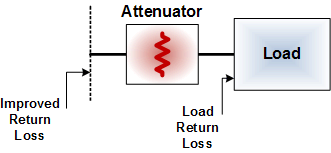|
By inserting a matched (nominal system impedance) attenuator in front of a mismatched
load impedance, the mismatch "seen" at the input of the attenuator is improved by an amount equal to twice the value
of attenuator. The explanation is simple.
 Return
loss is determined by the portion of the input signal that is reflected at the load (due to
impedance mismatch) and returned to the source. A perfect load impedance (complex conjugate
of the source impedance) would absorb 100% of the incident signal and therefore reflect 0% of it back to
the source (return loss of ∞ dB). Return
loss is determined by the portion of the input signal that is reflected at the load (due to
impedance mismatch) and returned to the source. A perfect load impedance (complex conjugate
of the source impedance) would absorb 100% of the incident signal and therefore reflect 0% of it back to
the source (return loss of ∞ dB).
For the sake of illustration, assume that the load is an open (or short) circuit, where 0% of the incident signal
is absorbed by the load and 100% is reflected back to the source. The reflected signal would therefore have a return
loss of 0 dB. Insert a 3 dB attenuator in front of the load. Now the incident signal is referenced to the
input of the attenuator.
As signal at the input of the attenuator will experience a 3 dB reduction in power by the time it reaches the
load. That 3 dB less power will be 100% reflected by the load and experience another 3 dB reduction in power by
the time is returns back to the input, for a total loss of 6 dB. The same principle applies for a load anywhere(§)
between zero and infinite load impedance (short and open circuits, respectively).
Calculate the improved VSWR as follows. Note that by my convention the loss value is returned as a positive number,
since the word "loss" implies the negative. If it were to be termed "return gain," then the result would be reported
as a negative number. Equally qualified experts will disagree on whether return loss should take on a negative value
or a positive value; the important thing is to keep the sign correct in your calculations; i.e., if you use a positive
value, then subtract it, and vice versa.
Of course, the method can be reversed to predict the attenuator required to improve a load VSWR by a predetermined
amount. To do so, calculate the desired return loss and subtract the known load return loss. Divide the answer by
two to get the attenuator value needed.
Here is a JavaScript calculator for
VSWR / Return Loss / Reflection
Coefficient / Mismatch Error / Improvement
See the
VSWR
Calculator page.
§ Actually, the attenuator is only rated for its specified attenuation level when it is
connected between two nominal impedances. Therefore, the attenuator will either have to be designed to closely match
the two impedances at its input and output (source and load, respectively), or an adjustment will need to be made
in the specified attenuation value to compensate for the mismatched load impedance.
Related Pages on RF Cafe - VSWR - Return Loss
- Γ Conversions -
VSWR <--> Return Loss <--> Γ
Conversion Calculator - VSWR Mismatch Errors
- VSWR Reduction by Matched Attenuator
|








 Return
loss is determined by the portion of the input signal that is reflected at the load
Return
loss is determined by the portion of the input signal that is reflected at the load 

